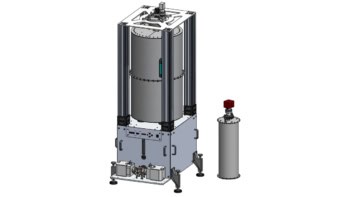
A compact, low-cost and low-power metal detector that can identify the unique magnetic fingerprints of small metallic objects has been created by a team led by Huan Liu at the China Institute of Geosciences. Comprising micrometre-scale sensor arrays, the instrument is sensitive to subtle disruptions of the Earth’s magnetic field that are caused by metallic objects. The new design could allow for significant reductions in the size and energy requirements of security screening systems.
The ability to detect hidden metallic objects is a critical requirement of public security systems. This is currently done by metal detectors that use inductor coils to transmit alternating electromagnetic fields, which inducing eddy currents within metallic objects. These eddy currents generate secondary fields of their own, which are picked up by the coils. While effective, such systems are bulky and consume large amounts of energy.
Liu’s team has developed an alternative technique that focuses on time-dependent variations in the Earth’s magnetic field, which are affected by the presence of nearby metal objects. The effect gives an object its own unique magnetic “fingerprint”, which depends on factors including the object’s shape, size, and composition. These fingerprints can be identified using a technique that the team has dubbed “weak magnetic detection”’ (WMD). This is a passive detection technique that does not transmit a probe signal — which means it has very low energy requirements.
A downside of WMD had been that the fingerprints of smaller objects are difficult to distinguish from background noise, and this had precluded its practical use in security scanning applications.
Central processing
Now, Liu and colleagues have shown that the signal-to-noise ratio of WMD can be improved using microelectromechanical systems (MEMS). These are arrays of micrometre-scale components that are highly sensitive to ambient electromagnetic fields and send information to a central unit for processing.
The detection mechanism is anisotropic magnetoresistance (AMR), whereby the electrical resistance of a detector component is a function of the strength and direction of an external magnetic field. This means that when the arrays are placed in a planar cross arrangement, noise can be significantly reduced.

New tuner could bring terahertz to the masses
The team’s metal detector integrates three sets of magnetic sensor arrays with a microcontroller, a battery, and a PC that provides a noise-suppressing data processing framework. With this setup, the physicists successfully identified the magnetic fingerprints of metal objects smaller than 50 cm; and could distinguish between multiple objects separated by under 20 cm. Specifically, they picked up the characteristic field mutations induced by objects including a phone, a hammer, and a knife. Larger objects such as the hammer could be detected at distances up to 80 cm.
Liu’s team now hopes to improve the accuracy of their sensor arrays to detect magnetic fingerprints from even further distances, and to higher resolutions.
The detector is described in AIP Advances.



